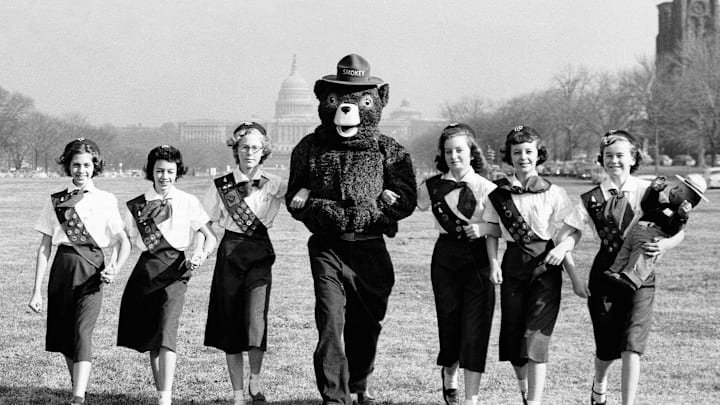Forest fires posed a terrifying threat during World War II. Fighting wildfires required huge amounts of precious manpower that otherwise could have been put toward building tanks or guns. Infernos also swallowed up thousands of acres of wood, a crucial ingredient in everything from warships to gunstocks.
To curb forest fires, the U.S. Forest Service and the War Advertising Council teamed up on a propaganda campaign. Walt Disney loaned the government the use of forest-dwelling Bambi for a year to get things rolling, but the Forest Service wanted its own anti-fire mascot. Commercial illustrator Albert Staehle drafted an image of a shovel-toting bear. It took a few drafts, but after some government-mandated tweaks—including making the bear wear pants—Smokey was born.

When Smokey debuted in 1944, his first posters bore the slogan “Smokey says—Care will prevent 9 out of 10 forest fires!” Although the words weren’t as catchy as the venerable “Only YOU can prevent forest fires”— a line he picked up in 1947—the character resonated with the public. Soon, Smokey was showing up on billboards and in magazines, and Americans became a bit more careful with their campfires and cigarette butts.
When forestry workers rescued an injured bear cub from a New Mexico wildfire in 1950, veterinarians managed to nurse him back to health, and the Forest Service adopted the cub as the living version of Smokey. He eventually came to live at the Smithsonian’s National Zoological Park in Washington, D.C., where he became a beloved advocate for forest fire prevention. The bear received so much fan mail that in 1964 he got his own ZIP code (20252).

Today, the Smokey Bear wildfire prevention drive is the longest-running public service announcement campaign in American history. According to the Smithsonian Institution Archives, the number of forest fires in the U.S. dropped from 201,511 in 1942 to fewer than 145,868 in 1974, despite the midcentury boom in population and development. The areas of burned forest fell from 31 million acres to under 3 million acres in that period, while officials estimated that Smokey’s influence preserved 16 million dollars’ worth of timber, watersheds, and public recreation areas.
Even now, the Department of Agriculture, of which the Forest Service is a part, pulls in more than $1 million a year licensing Smokey’s likeness, all of which goes to—you guessed it—fire prevention programs.
Read More Stories About Advertising:
This article originally appeared in mental_floss magazine. It has been updated for 2024.
